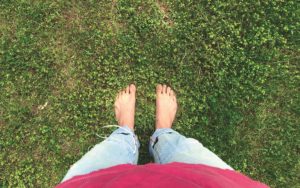I’ve learned some things navigating this new normal as a single person living in a one-bedroom apartment. One is that there are things we can do to adapt and get through this.
I spent the first eight weeks of the stay-at-home phase with my family. My parents fall into the vulnerable population category. Luckily, my siblings live close by. We made a plan, broke off into “pods,” and started communicating more than ever.
It was lovely to have a focus and solve problems as they arose. But that purposeful phase was short-lived. Only so much coordination of food and medicine pickups was needed. I couldn’t continue to sleep on my brother’s couch. I needed to face facts and come home to the Cape. Which would mean staying isolated in my one-bedroom apartment. Alone.

I am an introvert by nature. Living alone has never been an issue. I love and need solitude. But anyone who knows me well knows that I live for hugs. For years, I insisted on hugging my friends for no less than 15 seconds. Research has repeatedly shown that longer-than-normal hugs elicit oxytocin, a hormone released when we feel loved and cared for, a fact that I would throw at anyone who looked like they would listen. This new and necessary physical distancing would not be easy. I felt anxious about being alone and procrastinated about leaving.
Isolation is dangerous. There is a reason it is used in the prison system as punishment. But I am also aware of the dangers of our current viral pandemic. My parents live in an especially hard-hit area. One slip-up could be catastrophic to their health.
There is no debate that “social distancing” — I like to say “physical distancing” — has stunted the spread of the virus. The data in New York City and surrounding areas are clear. The vulnerable among us, and maybe all of us, may need to keep this up for some time.
During my initial 14-day quarantine after arriving home, I researched ways we can maintain this physical isolation without collectively losing our minds. FaceTime, Zoom calls, and other video chat programs can offer wonderful support, but they sometimes leave us feeling empty. I blame the lack of eye contact, connection issues, and the weirdness of time lags.
There is more we can do beyond videoconferencing. The next steps depend on your level of vulnerability. Multiple articles have both detailed and demonized “quarantine pods.” Forming one involves carefully selecting people from separate households to join and ride out the social-distancing storm.
The process is intricate. Clear communication is essential, as you are taking on each other’s risks, vulnerabilities, and points of contact. Some epidemiologists have urged folks to be careful or simply not do it at all. The risks need to be weighed appropriately. Your pod essentially becomes a single entity. If one person in the pod puts herself at risk, the whole unit is at risk. Is anyone in your potential pod vulnerable? How much contact does every single person have? Social chains that seem small can get complicated quickly. If done correctly, however, you could have help with child care, cooking, and hugs.
If a quarantine pod seems too complicated, or is simply out of the question, there are other options. I have yet to form a pod, as the process seems more daunting than dating at this point. For now, I’m spending lots of time under a weighted blanket on the couch.
For decades, weighted blankets have been used with psychiatry patients to ease anxiety. It’s become my go-to for human-free hugs. Penn Medicine reported last year that “a weighted blanket uses ‘pressure therapy’ — using a calm-inducing amount of pressure on your entire body, similar to the feeling of being hugged, swaddled, stroked, or held.” They’re widely available online and wildly helpful. I am a believer.
I’ve also been spending time barefoot in my back yard. This becomes easier on the Cape as the weather warms. “Earthing,” “grounding,” or, more plainly put, intentional outdoor walking while barefoot, has become the darling of environmental medicine research. In the last decade, there have been over 75 peer-reviewed publications detailing the positive effects of Earthing, which involves spending just 30 to 40 minutes barefoot outside.
It seems so simple. The effects seen in studies include decreased stress, improved sleep, reports of increased well-being, reduced pain, and reduced inflammation. Every time I step outside, I spread and wiggle my toes. I imagine the Earth rising up to support my feet just as much as I step down. This alone comforts me.
The timeline of physical distancing may be long. But knowing these workarounds makes me feel like I can make it. I’ll adapt. I’ll be either outside barefoot waving to people as they drive by or inside with my human-free-hug machine. I can do this. You can do this.
